Brined Turkey Breast Torrisi
This was one of the recipes that I took away from my great lunch with Mario Carbone and Rich Torrisi of Torrisi Italian Specialties in New York’s Little Italy. Turkey is, of course, an all-American product that was brought back to Europe after the discovery of the New World, and it is still not big on tables in Italy. But in this recipe, traditional technique and New World bird combine to make a delicious hybrid. “Sous-vide,” French for “without air,” is a technique of cooking food sealed in a plastic bag. Such foods usually cook for a long time at a low temperature, about 140 degrees F. The integrity of the product is preserved, and, when vacuum-sealed, the food will last longer. To perform this technique properly, one needs a lot of expensive and cumbersome equipment. Some contemporary restaurant chefs use it, and with good results, but I certainly do not recommend it for home use.
Recipe information
Yield
serves 8
Ingredients
for the brine
for the turkey and glaze
Preparation
Step 1
The day before you want to cook the turkey breast, make the brine: Combine 2 gallons cold water with the salt, sugar, lemons, lemon juice, and bay leaves in a large pot. Bring to a boil just long enough to dissolve the salt and sugar, then remove from heat and let cool completely. Submerge the turkey breast in the brine, weighting it down with a plate. Refrigerate 24 hours while the turkey brines.
Step 2
When you are ready to cook the turkey, drain and rinse it. Lay out a large sheet of doubled plastic wrap, and make a bed with the leek and celery in the center. Lay the turkey on top of the vegetable bed, and wrap the turkey snugly in the plastic wrap, using more if necessary to seal the package completely. Put the turkey breast in a gallon-sized resealable plastic bag. Seal most of the way, then slip a straw into the bag and suck out the excess air. Seal completely.
Step 3
Put the wrapped and bagged turkey breast in a large pot, and add enough water to cover. Adjust the heat to maintain a constant temperature between 170 and 180 degrees F. Cook the turkey for 40 minutes; then puncture the plastic with a meat thermometer to insert it in the breast. The internal temperature in the breast meat should reach 165 degrees F when done.
Step 4
While the turkey cooks, preheat oven to 375 degrees F. Place each garlic head on a square of foil, drizzle with olive oil, and wrap the foil to seal. Roast in oven until the garlic is tender throughout, about 30 to 40 minutes, depending on the size of the garlic heads. Remove from oven and let cool. Squeeze out the garlic cloves from the skin into a bowl, and mash with the honey, vinegar, salt, and 2 tablespoons hot water.
Step 5
Increase the oven temperature to 425 degrees F. When the turkey has finished poaching and reached an internal temperature of 165 degrees F, place the package in an oiled roasting pan and cut open the bag and plastic wrap, letting the cooking juices flow into the pan, then remove the turkey from the bag and return it to the roasting pan. Brush the glaze onto its skin. Return the roasting pan to the oven, and roast until the skin is browned and crisp, about 20 minutes. Let rest 10 minutes before carving.
